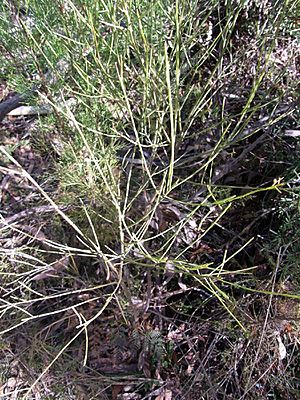Leptomeria acida facts for kids
Quick facts for kids Leptomeria acida |
|
|---|---|
 |
|
| Blue Mountains National Park, Australia | |
| Scientific classification | |
| Genus: |
Leptomeria
|
| Species: |
acida
|
Leptomeria acida, also known as acid drops or sour currant-bush, is a special type of plant found in eastern Australia. It grows along the coast and in the mountain ranges. This shrub looks like it has no leaves, but it actually has tiny ones!
What makes this plant unique is that it's a parasitic shrub. This means it gets some of its food and water by attaching to the roots of other plants. It often grows in dry eucalyptus forests, especially in places that are a bit sheltered.
Contents
Discovering the Acid Drops Plant
What Does Leptomeria acida Look Like?
The Leptomeria acida plant has stiff, angled branches that spread out. In summer, it grows pretty red flowers. These flowers appear in clusters called racemes, which are about 15 to 20 millimeters long.
The Fruit of the Sour Currant-Bush
After the flowers, the plant produces small fruits. These fruits are called drupes. They can be green or reddish, and sometimes they have a purple tint. Even though the plant looks leafless, it does have very tiny leaves, only 1 to 2 millimeters long, but they are hard to spot.
How People Use Acid Drops
The fruits of the Leptomeria acida plant are quite special. They contain vitamin C, which is good for you! Long ago, Indigenous Australians ate these fruits. They were a natural source of food.
Today, people can still use these fruits. They are sometimes used to make jelly. The name acida in the plant's scientific name refers to the pleasant, slightly sour taste of the fruit.
Who Discovered This Plant?
The Leptomeria acida plant was first written about by scientists in 1810. A very famous Scottish botanist named Robert Brown described it in his book, Prodromus Florae Novae Hollandiae. He was known for discovering and naming many plants from Australia.
Images for kids


